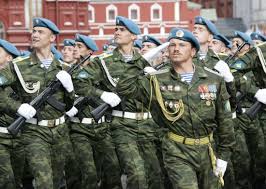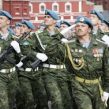
Putin Signs New Military Doctrine: Core Elements Unchanged
Publication: Eurasia Daily Monitor Volume: 12 Issue: 2
By:

President Vladimir Putin has introduced a new Military Doctrine in the context of the Ukraine crisis, deteriorating relations with the United States, the European Union and the North Atlantic Treaty Organization (NATO), as well as shifts within the international security environment. However, the doctrine appears innately defensive in its tone and content, offering some adjustments to the 2010 Military Doctrine, but retaining most of its core elements. The new doctrine notes Russia’s strategic interests in the Arctic and introduces a reference to non-nuclear deterrence (2014 Military Doctrine, December 26, 2014).
According to the presidential website, the decision to order a new Military Doctrine was taken on July 5, 2013, during a meeting of the Russian Security Council. Therefore, the revision of the 2010 Military Doctrine began prior to the Ukraine crisis and could not have been driven solely by that crisis. On the other hand, Putin’s instruction to the Security Council in September 2014 to complete the drafting of the new doctrine within three months was most likely influenced by the Ukraine crisis and the US and NATO response—including the Western-imposed sanctions regime, the exclusion of Russia from the G8, and the North Atlantic Alliance freezing its relations with Moscow. A meeting of the Security Council on December 19, 2014, considered and approved the new doctrine, which was signed into law on by President Putin on December 26 (Kremlin.ru, December 26, 2014).
Putin’s decision to accelerate the drafting of the Military Doctrine prompted widespread speculation concerning the intentions that might be signalled in the revised version of the security document. This included the country’s nuclear posture, threats and dangers to the state and whether the 2014 doctrine would label the US and NATO as enemies. Russian experts, however, urged caution and forecast a revision of the doctrine that would be inherently defensive. The nuclear posture would remain unchanged and only minor changes were being considered. If anything, the new incarnation of the Military Doctrine represented an opportunity to correct some aspects in line with the organizational transformation in the Russian military (Voyenno Promyshlennyy Kuryer, December 17, 2014; Nezavisimoye Voyennoye Obozreniye, December 15, 2014).
On December 26, these Russian experts were proven correct in their assessment: the nuclear posture is unchanged, in fact it removes the reference to nuclear weapons in the context of regional conflict contained in the 2010 doctrine, and leaves much of the original threat assessment unchanged (2014 Military Doctrine, December 26, 2014; 2010 Military Doctrine, February 5, 2010). Viktor Baranets, a military expert and commentator for Komsomolskaya Pravda, also highlighted the defensive nature of the 2014 Military Doctrine and its consistency with the earlier version. The doctrine anticipates closer military cooperation between Russia and former Soviet Republics, as well as with China, India and Latin America. Special emphasis in this regard is placed on Belarus, Abkhazia and South Ossetia (LifeNews, December 30).
The 2010 doctrine made a distinction between opasnosti (dangers) and ugrozy (threats) facing Russia. This permitted Moscow to continue to oppose NATO enlargement (rather than the Alliance as such) and out-of-area operations without designating it as a threat. This distinction is preserved in the 2014 doctrine (2014 Military Doctrine, December 26, 2014; 2010 Military Doctrine, February 5, 2010). The 2014 doctrine describes the international security environment as follows: “World development is characterized at the present stage by a strengthening of global competition and of tension in various areas of inter-state and inter-regional interaction, by the rivalry of values and models of development, by instability of economic and political development processes at global and regional levels against the background of a general complication of international relations. There is a phased redistribution of influence in favor of new centers of economic growth and political gravitation” (2014 Military Doctrine, December 26, 2014).
To the list of external military threats the new doctrine adds: “[the] establishment of regimes in states contiguous with the Russian Federation, including as a result of the overthrow of legitimate state authorities, and having a policy threatening interests of the Russian Federation; subversive activities of special services and organizations of foreign states and their coalitions against the Russian Federation” (2014 Military Doctrine, December 26, 2014). In section II.15 on the features of modern military conflicts, it adds: “[the] participation of irregular armed force elements and private military companies in military operations; use of indirect and asymmetric methods of operations; use of political forces and public movements financed and controlled from outside” (2014 Military Doctrine, December 26, 2014).
In section III, the 2014 Military Doctrine adds, “Employment of the Armed Forces, other troops, and entities in peacetime shall be by decision of the President of the Russian Federation in accordance with the procedure established by federal legislation. The Armed Forces, other troops and entities shall be employed decisively, purposefully and comprehensively based on advance and constant analysis of the military-political and military-strategic situation taking shape” (2014 Military Doctrine, December 26, 2014).
By far the most intriguing shift in the new doctrine is found in section I.8, which refers to a system of non-nuclear deterrence: “system of nonnuclear deterrence—a complex of foreign-policy, military, and military-technical measures aimed at preventing aggression against the Russian Federation by non-nuclear means” (2014 Military Doctrine, December 26, 2014). This was signalled in earlier interviews by Army-General Yury Baluyevskiy, the former chief of the General Staff, who noted that Russia needs a system of non-nuclear deterrence; which appears to be a culmination of theoretical military thinking on “pre-nuclear deterrence” (see EDM, November 18, 2014). Despite its inclusion in the doctrine it remains unclear as to how this may be developed in practical terms.
Russia’s 2014 Military Doctrine offers no tangible support to those who argue that Moscow has adopted a more aggressive military posture. The doctrinal revisions are modest, stepping back from designating the US or NATO as military threats, while expressing concern about potential crisis escalation. Since 2010, the Arab Spring, the deterioration of security in the Middle East and North Africa, as well as the NATO exit from Afghanistan influenced Russian doctrinal thinking. In terms of the Ukraine crisis and US/NATO relations with Russia, the doctrine offers some insight into how Moscow views the international order in late 2014. Nonetheless, since oil prices have fallen and the ruble has suffered decline against the dollar, it is likely that the new doctrine will prove to be largely aspirational. In short, it offers no answer to the “guns or butter” question now plaguing the Kremlin.




